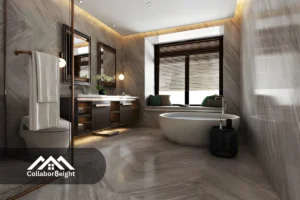An art deco bathroom instantly turns an ordinary routine into a small ritual of glamour. Rooted in 1920s geometry & luxe finishes, this look balances bold graphics, polished metals, and tactile materials so a tiny powder room or a full master bath can feel curated without fuss. In this guide you will get clear design direction, practical layouts, spec choices, styling tips, and sourcing ideas to execute an authentic yet modern Art Deco Bathroom that works for your budget.
Why Art Deco Bathroom Design Is Perfect for Your Space
The style basics
Art Deco is about geometry, symmetry, contrast, & rich materials. It translates well to bathrooms because tile patterns, mirror shapes, and metal finishes naturally create focal points. Use one or two dramatic elements, floor tile, mirror, or vanity, then let fixtures and finishes support the mood.
Historic note that matters
Art Deco emerged in France in the 1920s as a celebration of craftsmanship and modern luxury. Its emphasis on strong lines & expensive-looking surfaces makes it ideal for compact rooms where details read as intentional drama.
Short transition: now we move from what Art Deco is to how to plan the space.
Planning: Layout, Lighting & Practical Limits
Key planning questions
- Can the room hold a statement piece (vanity, freestanding tub, tile field)?
- What plumbing or electrical changes are realistic?
- Which surfaces need moisture resistance (walls, grout, mirrors)?
Scale & focal point selection
Choose one focal point: patterned floor, dramatic mirror, or a green marble feature wall. In small baths pick a mirror and light treatment to add depth while avoiding heavy cabinetry.
Lighting plan essentials
Layer lighting: a sculptural ceiling fixture for style, wall sconces flanking the mirror for task, & hidden LED cove or mirror backlight for ambience.
Practical finish choices
Use glazed tiles, lacquered cabinetry, brass or chrome hardware with protective lacquer, and fog-free mirrors. Avoid porous stones near wet zones unless sealed.
Quick transition: with the plan clear, let’s pick the palette & materials.
Palette, Surfaces & Material Play
Palette ideas that feel right
- Classic black & white: crisp, high contrast, timeless.
- Emerald or deep green with gold: vintage luxe with modern energy.
- Muted jewel tones with warm marble: opulent without being showy.
Tile choices that read Art Deco
Geometric encaustic tiles, chevron subway tiles, hexagon mosaics, & fan-shaped motifs read authentic. Use a bold geometric floor as the stage; keep wall tile simpler for balance.
Metals & hardware
Choose polished brass, antique brass, or satin chrome. For a green bathroom, pair warm brass with deep marble for richness. Consider fluted or stepped detailing on handles & faucets.
Vanity & cabinet styling
Fluted cabinet faces, lacquered finishes & mirrored panels feel period-accurate. For small bathrooms, a floating vanity with slim legs keeps visual weight low while showing off an under-seat rug or patterned floor.
Transition: fixtures and mirrors are the most visible expression, here’s how to choose them.
Fixtures, Mirrors & Fixtures That Make the Room
Fixture selection rules
- Pick one high-impact item (e.g., freestanding tub or sunburst mirror) then coordinate fixtures.
- Keep plumbing finishes consistent across faucet, shower trim & accessories.
- Balance curves with geometry: a rounded basin can soften an angular tile field.
Mirror strategies
Mirrors are central to Art Deco. Look for geometric shapes, arched, octagonal, sunburst or mirror frames with radiating lines. A backlit oval or rectangular mirror with a brass bevel reads luxe and keeps the space bright.
Bathtubs & basins
A low-profile rectangular tub in porcelain or a shallow freestanding tub with a rounded base gives a classic look. Pedestal or integrated basins with stepped detailing feel period-appropriate.
Lighting fixtures to pair with mirrors
Use vertical wall sconces on either side of the mirror for even task light. A small chandelier or pendant with stepped geometry can land above a freestanding tub in a larger bath.
Short transition: details finish the story hardware, textiles & art.
Accessories, Art & Textiles
What to add (and what to skip)
Add:
- A sculptural mirror or brass-framed mirror as the centerpiece.
- One or two framed prints with geometric motifs or vintage Art Deco poster reproductions.
- Plush towels in a single saturated tone to complement tile or marble.
Skip clutter. Let one statement artwork or mirror carry the visual weight.
Art selection
Look for black-and-white lithographs, chrome or brass-framed small art pieces, or a single vertical print that echoes tile geometry. Keep frames simple to avoid visual competition.
Towels, rugs & shower curtains
Choose simple luxury: heavy-weight towels, a low-pile geometric rug, and a solid-color shower curtain in velvet-linen blends for texture.
Small accessory ideas
- Brass tray for toiletries.
- Step-pattern soap dish or a geometric toothbrush holder.
- Vintage perfume bottles or glass apothecary jars for counter styling.
Transition: below are specific designs for common constraints.

Design Recipes (Real, Repeatable Plans)
Small bathroom: bold mirror and tile band
- Use a geometric floor tile in the entry half only.
- Install a tall, narrow mirror with brass trim to visually raise the ceiling.
- Add a floating vanity with fluted drawer front for texture.
Medium bathroom: green marble focal wall
- Apply a vertically veined green marble behind the vanity or tub.
- Use complementary emerald accessories & warm brass fittings.
- Keep remaining walls in neutral glazed tile for balance.
Full master bath: dedicated glamour zone
- Freestanding tub, statement chandelier, mirrored vanity faces.
- Patterned marble or black-and-white mosaic at floor + plastered walls.
- Built-in linen cabinet with stepped fluting detail.
Micro-case insight: A 120 sq ft master bathroom converted in 2025 used a single 3 x 6 emerald marble slab behind the tub, matched with a matte black vanity & brass hardware. The client prioritized fewer seams & fewer grout lines, producing a cleaner, more luxurious read while saving 12% on tile labor because of fewer cuts. (example)
Transition: now the technical and installation notes.
Technical & Installation Rules You Cannot Ignore
Waterproofing & substrate
Waterproof membrane under tile is mandatory in wet areas. Use cement backer board, sealed seams, and epoxy grout where possible.
Ventilation & mirror placement
Ensure a ventilation fan meets the room’s cubic feet per minute (CFM) requirement. Position mirrors so fans & vents do not create drafts across warm surfaces that cause fogging.
Electrical & lighting safety
Use damp-rated fixtures for vanity lights & wet-rated fixtures for any overhead lights near shower or tub. Keep switches and outlets at code distances from water sources.
Transition: SEO content needs image alt text & metadata; but for your real project these quick copy cues work.
Sourcing: What to Buy Where
Prioritized purchases for impact
- Mirror first: defines scale & mood.
- Floor tile second: anchoring statement.
- Vanity/fixture third: ties finishes together.
Budget buckets
- High impact, low cost: mirror, wall sconce, paint or wallpaper.
- Midrange: custom vanity, unique tile.
- High spend: marble slabs, freestanding tubs, bespoke lighting.
Short practical note: Look for vintage mirrors in salvage stores for authentic patina or buy a modern reproduction for budget control.
Common Styling Mistakes & Fixes
- Over-patterning: fix by limiting patterns to one large field.
- Mixed metals gone wrong: choose one metal family for visible fixtures; accent with one contrasting metal sparingly.
- Too many small accessories: pick 3 curated items, not a shelf full.

FAQs
What if my bathroom is tiny, can I still do Art Deco?
Yes. Use a single bold mirror, vertical lighting, & reflective surfaces. Keep fixtures compact & avoid heavy cabinetry.
Is green a true Art Deco color choice?
Absolutely. Deep greens, emeralds & teal were used in vintage Deco interiors and pair beautifully with brass.
How do I modernize Art Deco without it feeling dated?
Balance period details with modern simplicity: pair Deco mirrors with minimal faucets, or use geometric tile with streamlined matte cabinetry.
Are vintage fixtures worth restoring?
Often yes—restoring an original brass faucet or mirror can add authenticity. Ensure plumbing meets modern safety & water-efficiency standards.
Key Takeaway
- Pick one dramatic element (mirror, tile, or vanity) & design around it.
- Favor geometry, symmetry & rich finishes; avoid pattern overload.
- Prioritize waterproofing, ventilation & coordinated metal finishes.
- Small bathrooms win with mirror + lighting; large baths with marble & a fixture moment.
Conclusion
Art Deco in the bathroom is not about copying a period room; it is about applying its principles—geometry, contrast, & material richness—in a way that suits modern life. Start with a single focal piece, be disciplined about finishes, and protect performance: the result should be elegant, durable, & functional.
When executed thoughtfully, an Art Deco bathroom elevates daily routines into moments of deliberate beauty. Use the recipes here, prioritize one strong element, protect plumbing & finishes, & you will get a bathroom that looks curated, not contrived.





